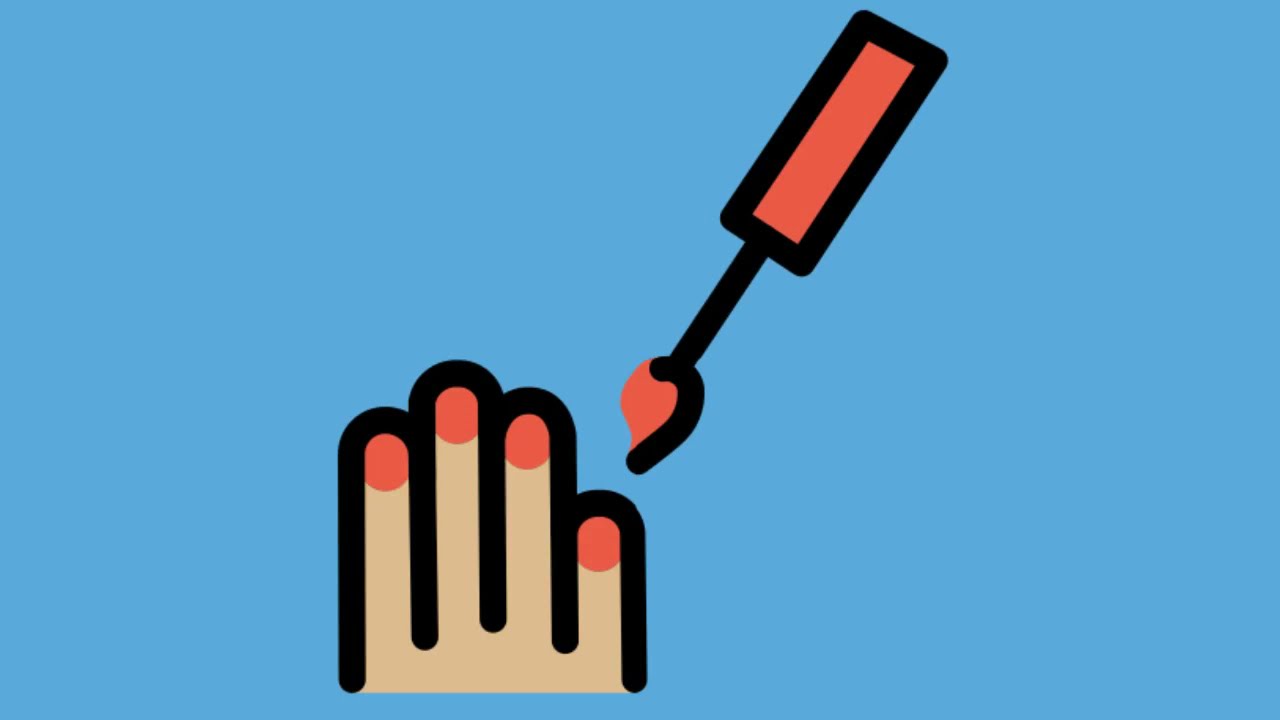💅 The nail polish emoji, also known as the manicure emoji, is a popular one used across social media platforms. It features a small bottle of nail polish with a brush attached to its cap. While it may seem like a simple and straightforward emoji, there’s more to it than meets the eye. In this article with Impeccable Nest, we will explore the various meanings of the nail polish emoji and how it is used in different contexts.

What Does the 💅 Emoji Mean?
The 💅 emoji is commonly used to represent beauty, self-care, and femininity. It is often used in conversations related to fashion, makeup, and personal grooming. Its usage is not limited to women; men who love to take care of their nails can also use this emoji to express their interest.
In some contexts, the 💅 emoji can be used to represent relaxation or leisure time. For example, if someone sends you a message saying they are getting a manicure or pedicure, you might respond with the 💅 emoji to convey your enthusiasm or support for their self-care routine.
Beyond just polished nails, the emoji has some additional meanings:
Beauty and self-care routines more broadly
One of the primary meanings associated with the “💅” symbol is that of beauty and self-care routines. This can include anything from facials and face masks to manicures and spa treatments. By using this symbol, someone can indicate their interest in taking care of themselves, feeling beautiful, and indulging in some pampering. In many ways, this symbol has become a shorthand way of conveying one’s dedication to personal grooming and wellness.
Expressing femininity or one’s feminine side
Another connotation of “💅” is the expression of femininity or one’s feminine side. In this context, people often use this symbol to showcase their love for all things girly, including makeup, dresses, heels, and other traditionally feminine items. It can also be used to describe someone who exudes femininity and grace, regardless of their dress or appearance. By using this symbol, individuals can celebrate their womanhood and feel empowered by their femininity.
Sass and confidence (“throw shade”)
In addition to these positive connotations, “💅” can also be used to indicate sass and confidence. When someone “throws shade,” they’re essentially expressing their contempt or disdain for someone or something else. This could mean making snarky comments, rolling your eyes, or simply ignoring someone altogether. The “💅” symbol can be used to indicate that you’re feeling sassy, confident, and unapologetically yourself. It’s a way of saying, “I’m here, I’m fabulous, and I’m not going to take any nonsense.”
Dismissiveness and attitude (“don’t care,” “bye Felicia”)
However, “💅” can also be used to convey dismissiveness and attitude. When someone says “don’t care, bye Felicia,” for example, they’re essentially dismissing the other person and indicating that they’re not interested in what they have to say. This could be used in response to gossip or drama, or simply as a way of shutting down a conversation that isn’t going your way. By using the “💅” symbol, someone can indicate that they’re feeling dismissive or indifferent to the situation.
Gossip and drama (“spill the tea”)
Lastly, “💅” is often associated with gossip and drama. When someone “spills the tea,” they’re essentially sharing juicy details about someone else’s life or revealing a scandalous rumor. The “💅” symbol can be used to indicate that you’re ready to dish out some gossip or that you want to be in the know about all the latest drama. It’s a shorthand way of saying, “Let’s talk about what’s really going on.”
In conclusion, the “💅” symbol has become a versatile tool for expressing oneself in various aspects related to beauty, femininity, sass, confidence, dismissiveness, attitude, gossip, and drama. It’s a shorthand way of communicating complex feelings and ideas without having to spell everything out. Whether you’re indulging in some self-care or throwing shade at your haters, “💅” is a symbol that can help you express yourself in a fun and playful way.
How to Use the 💅 Emoji?
The 💅 emoji can be used in various ways, depending on the context of the conversation. Here are some examples:
- If someone shares a photo of their new nail color, you can respond with the 💅 emoji to show that you appreciate their choice.
- You can use the 💅 emoji to indicate that you are taking some time to pamper yourself, such as getting a manicure or doing an at-home spa treatment.
- If someone compliments your nails, you can respond with the 💅 emoji to show your gratitude and acknowledge their compliment.
Examples of Using the 💅 Emoji
Here are some examples of how the 💅 emoji can be used in different contexts:
- Sarah: Just got my nails done in a beautiful shade of pink! 💅
- Emily: Love it! That color looks great on you.
- Maria: Feeling so relaxed after a day at the spa. 💅
- Olivia: You deserve it!
- Jessica: I can’t wait to try out this new nail polish color! 💅
- Rachel: Let me know how it turns out!
Modern Uses and Meanings of the 💅 Emoji
Today, the nail polish emoji remains highly popular for its varied meanings:
Beauty and Self-Care
At its core, the nail polish emoji represents beauty, grooming, and self-care. People send it when:
- Getting a manicure or pedicure
- Doing their own nails at home
- Browsing nail polish colors
- Buying new beauty products
- Getting ready for a night out
- Pampering with a face mask or bath
It’s a way to proudly show off investing time into looking and feeling good.
Femininity
The emoji is strongly associated with femininity due to its origins and typical use cases. People may use nail polish 💅 when:
- Bonding over feminine interests and hobbies
- Supporting feminine energy and girl power
- Complimenting someone’s beauty or style
- Appreciating feminine icons and pop culture
It enables feminine expression and embracing the power in one’s womanhood or feminine side.
Sass and Attitude
One of the most popular uses of the nail polish emoji today is to convey attitude and sassiness. For example:
- “Don’t care” or “bye Felicia” (dismissiveness)
- “Spill the tea” or “gurl that’s the tea” (gossip/drama)
- “Throw shade” (insults/attitude)
- “Yaaas queen” (praise/hype)
The emoji adds emphasis to anything with fierce, unbothered energy. It’s all about confidence in oneself.
Conversation
In everyday conversations, the nail polish emoji may signify:
- Talking about manicures, pedicures, or nail trends
- Gossiping and talking about drama
- Complimenting someone’s appearance
- Sharing beauty tips and products
- Inviting someone to partake in self-care activities together
It’s a way to visually convey these beauty, gossip, and bonding-related topics.
The diverse meanings of the nail polish emoji make it highly flexible for digital communication about femininity, self-care, and fierceness. It enables self-expression with just one little icon.
Origins of the Nail Polish Emoji
The origins of the nail polish emoji can be traced back to the 1990s and early internet chat rooms and forums. It became popular especially among women and girls looking to bond over shared interests in beauty, fashion, and self-care.
Some key origins and uses:
- AOL Instant Messenger (1996): Many emojis first appeared on AIM, including the nail polish icon to represent beauty-related topics.
- LiveJournal forums (1990s): LiveJournal communities like MakeupAlley made extensive use of the 💅 emoji in subjects about nail trends.
- “Gurl” internet slang: The nail polish emoji was used in phrases like “spill the tea gurl” to add sassy emphasis.
- Myspace (2003): Myspace users embraced emojis like 💅 to personalize profiles and show interests.
- Early Twitter (2006): The emoji gained wider recognition on Twitter for expressing excitement about nail art and salon days.
So while the nail polish icon existed earlier, it grew to fame through 90s/early 2000s online forums and social networks dominated by young women. It enabled bonding over shared “girly” interests in a fun visual way.
Conclusion
The 💅 emoji is a versatile and popular emoji that can be used to express various meanings related to personal grooming, beauty, and fashion. While its most common use is associated with manicures and self-care routines, it can also represent confidence, femininity, and relaxation. It’s essential to consider the context and audience when using this emoji, as well as to be aware of any cultural differences that may affect its interpretation. So next time you want to express your love for nail art or show your enthusiasm for a friend’s new nail color, don’t forget to add the 💅 emoji to your message!
- The 💅 Nail Polish emoji is often used in conjunction with the 🙄 emoji to add an extra layer of snarkiness or sassiness to a message. The 💅 emoji shows a hand with painted nails, and it’s commonly used to represent fashion, beauty, and self-care. When used with the 🙄 emoji, the 💅 emoji can indicate that the speaker is unimpressed or dismissive of someone or something, implying that they are above it all and don’t have time for petty issues.
- The emoji combination of 😩 and 💅 could be interpreted in a few different ways, depending on the context and the person using it. One interpretation is that someone is feeling so frustrated or overwhelmed (😩) that they need to take a moment to focus on themselves and engage in some self-care or pampering (💅). Alternatively, the combination could be used in a more sarcastic or ironic way, implying that even in the midst of distress or chaos, the user is still able to prioritize their appearance or outward image.

I am Lois Mullins, an enthusiast in emoji deciphering. Over the recent years, I have continuously updated and delved deep into the knowledge of emoji decryption.
I take pride in my extensive knowledge of decoding emojis, particularly in the Emoji Meanings of Impeccable Nest . I believe that a profound understanding of decoding these symbols can be beneficial for individuals in comprehending the nuances of language when someone sends them an emoji.
By grasping the nuances and potential misinterpretations of these emotional symbols, I am confident that people can use them more effectively to express their emotions and build stronger connections with others. I am committed to sharing my knowledge with the community so that everyone can harness the power of emojis in their everyday communication.
If you are seeking an experienced individual ready to share their passion for emoji deciphering, I hope for the opportunity to collaborate and learn from others. Together, we can create innovative and unique communication experiences!
